Let’s be real – teaching is an exhilarating rollercoaster, but it’s not all sunshine and rainbows. We’ve all had those days where it feels like herding cats would be easier than managing our lively bunch of students.
It’s a universal truth: the quest for effective classroom management is an ongoing pursuit. The burning question remains: is there a one-shot approach that not only fosters a love for learning but also serves as a remedy for the trials of classroom management?
Well, enter the hero of our story: Inquiry-Based Learning (IBL). As educators, we’re no strangers to the hurdles of disengagement and distraction.
In this blog, we’re not just talking about effective Inquiry-Based Learning examples; we’re talking about sparking a revolution in how we teach and how our students learn. So, let’s dive in!
- Inquiry-Based Learning 101
- Inquiry-Based Learning Examples (With Use Cases!)
- Tips for Successfully Implementing Inquiry-Based Learning
Inquiry-Based Learning 101: A No-Nonsense Summary
Inquiry-Based Learning (IBL) is a student-centric educational approach that flips the traditional teacher-led paradigm. Instead of educators being the primary source of information, IBL empowers students to actively engage in their learning journey.
It is a teaching and learning approach that is rooted in constructivistism learning theory. It is a departure from the conventional teaching, with an emphasis on active engagement, questioning, investigating and exploration, transforming the classroom into a dynamic space where curiosity and questioning lead the way.

Let’s break down the fundamental principles that define IBL, shedding light on its pedagogical essence.
Key Principles of Inquiry-Based Learning
🌟 Curiosity as the Catalyst
Inquiry-based learning places a premium on cultivating curiosity within students. Encouraging questions and inquiry-driven exploration ensures that learning becomes a self-motivated pursuit.
🎓 Student-Centric Inquiry
In the inquiry-based learning model, students take on a more active role in their education. They formulate questions, investigate, and construct their understanding, fostering a sense of autonomy and responsibility for their learning.
🌐 Real-World Relevance
Lessons in inquiry-based learning are designed to bridge the gap between theoretical concepts and real-world applications. This connection not only enhances understanding but also addresses the practical relevance of the acquired knowledge.
🤔 Critical Thinking at the Helm
Inquiry-based learning prioritizes critical thinking skills over rote memorization. Students are prompted to analyze information, evaluate its significance, and apply their knowledge to solve problems, honing skills essential for lifelong learning.
🤝 Collaboration as the Cornerstone
Collaboration is a central tenet of inquiry-based learning. Students work together, sharing ideas, perspectives, and insights. This not only enriches the learning experience but also prepares them for collaborative endeavors in future academic and professional settings.
Types of Inquiry-Based Learning
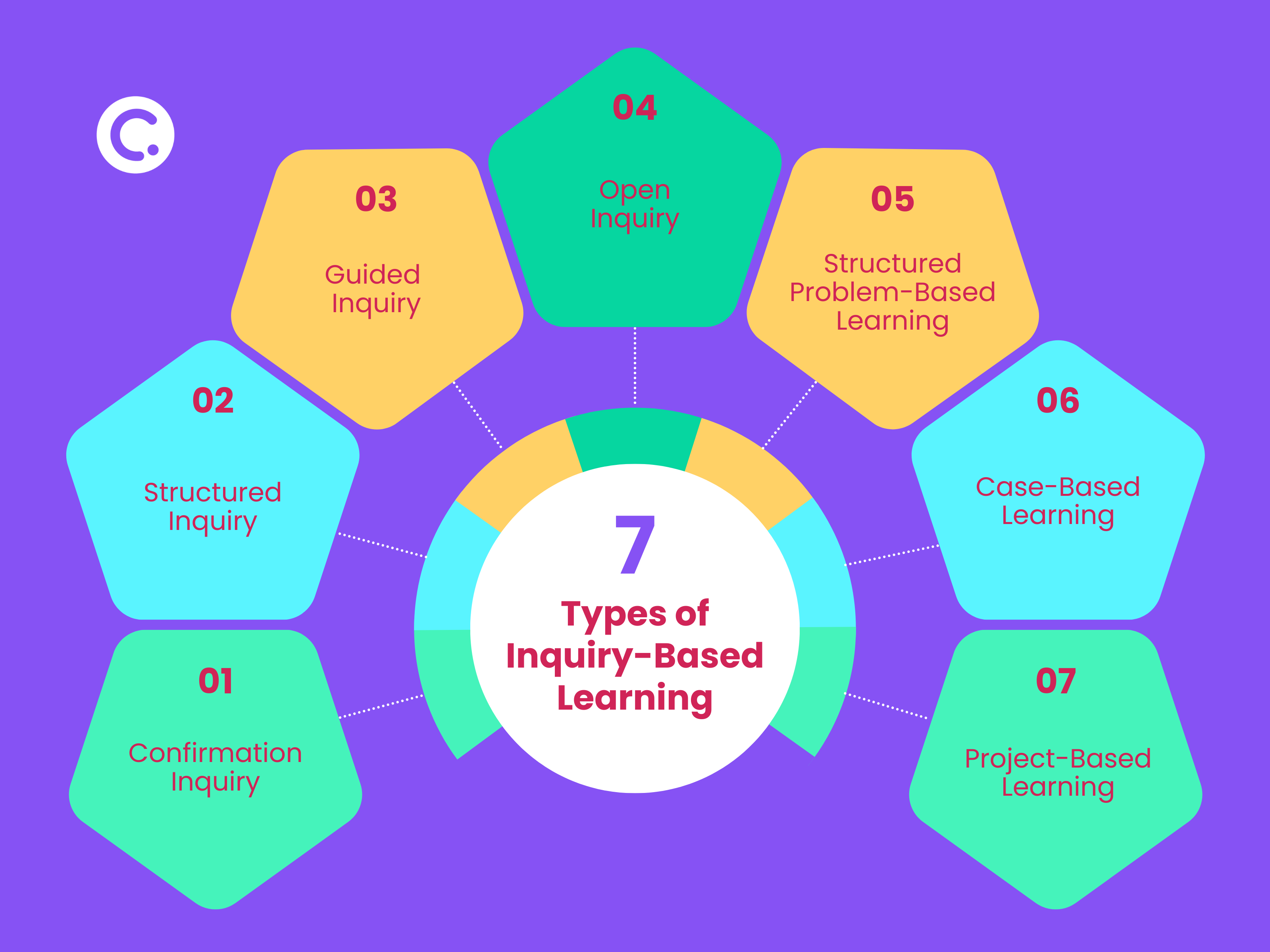
Are there more to Inquiry-Based Learning (IBL) than just its very essence, you ask?
Yes, there are different approaches of IBL, each offering variations in how students engage in the inquiry process. Here are a few common types:
- Confirmation Inquiry
In this approach, students initiate the process with a specific question or hypothesis. The teacher then takes on a guiding role, leading them through structured steps to investigate and ultimately confirm or challenge their initial ideas.
⭐️ When it’s best used: Ideal for introducing the scientific method in science classes or when reinforcing a particular concept with a clear hypothesis. - Structured Inquiry
Teachers lay down a framework or a set of procedures for investigation, providing students with a structured path. Within this framework, students have the freedom to pose questions and explore, striking a balance between guidance and autonomy.
⭐️ When it’s best used: Effective when introducing research methods, especially for younger students or those new to inquiry-based learning. - Guided Inquiry
Under the guided inquiry model, students confront a broad question or problem that demands resolution. The teacher assumes the role of a facilitator, offering support and guidance as students develop their research plans to arrive at a solution.
⭐️ When it’s best used: Suitable for more complex topics, encouraging students to delve deeper into a subject with the guidance of the teacher. - Open Inquiry
Open inquiry provides students with the liberty to choose their research questions. They are tasked with developing their investigative procedures, emphasizing the need for advanced critical thinking skills to navigate the exploration process.
⭐️ When it’s best used: Ideal for advanced learners or when the goal is to encourage independent thinking and research skills. - Structured Problem-Based Learning (PBL)
This method immerses students in real-world problems, prompting them to investigate and devise solutions collaboratively. The focus is on applying inquiry to practical challenges, preparing students for real-world problem-solving.
⭐️ When it’s best used: Effective for teaching practical skills and problem-solving in various disciplines, promoting teamwork and critical thinking. - Case-Based Learning
Students engage in the analysis and resolution of real or hypothetical cases, applying their knowledge within specific contexts. This method emphasizes the practical application of acquired knowledge to solve problems.
⭐️ When it’s best used: Suitable for disciplines where context is crucial, such as law, medicine, or business, as it helps students understand how theoretical knowledge applies in real-world scenarios. - Project-Based Learning (PBL)
While not strictly inquiry-based, PBL often incorporates elements of inquiry. Students undertake extended projects, delving into complex problems over an extended period, fostering collaboration and critical thinking skills.
⭐️ When it’s best used: Effective for interdisciplinary projects, allowing students to apply knowledge from various subjects to solve a complex problem.
It is important to note that as IBL Is a modern teaching philosophy, teachers should adapt to newer medium of instruction when teaching using IBL. Play around different EdTech tools that could go well with the type of IBL approach you're going with. A top tip: ClassPoint. Seamlessly integrated into Microsoft PowerPoint, ClassPoint lets you and your students get the best of both worlds - accessibility and interactivity. Pull out some fun interactive quizzes, paired with an engaging gamification inside PowerPoint. And not just that, make PowerPoint presentations more dynamic than ever with handy presentation tools made for the on-the-go you. And has AI finally arrived in PowerPoint? It definitely has with ClassPoint's AI Quiz Maker!
Contrasting Traditional Approaches with Innovative Inquiry-Based Learning Methods
In the educational landscape, the clash between traditional teaching methods and innovative approaches like Inquiry-Based Learning (IBL) is palpable. Let’s dissect the key differences to highlight why IBL is not just a deviation from the norm but a transformative educational philosophy.
👩🏻🏫 Traditional Teaching Methods
In traditional classrooms, teachers often play the role of knowledge dispensers. Information flows unidirectionally from teacher to student, with an emphasis on memorization and standardized assessments. The curriculum tends to be predetermined, leaving little room for student input or exploration. The focus is on covering content rather than nurturing a deep understanding.
💙 Innovative IBL Methods
On the flip side, IBL flips the script. Students take center stage as active participants in their learning journey. Instead of a one-size-fits-all curriculum, IBL thrives on adaptability. It encourages students to question, explore, and construct knowledge collaboratively. The emphasis is on critical thinking, problem-solving, and real-world application, preparing students not just for exams but for the challenges beyond the classroom.
Key Contrasts
| Aspect | Traditional Teaching Methods | Innovative IBL Methods |
| Role of Teachers | Teachers as knowledge providers. | Teachers as guides and facilitators. |
| Student Involvement | Passive recipients of information. | Active participants, driving their learning. |
| Curriculum Approach | Predetermined and fixed. | Adaptable, responsive to student interests. |
| Learning Focus | Emphasis on memorization and assessments. | Critical thinking, problem-solving, and application of knowledge. |
| Assessment Methods | Standardized testing and rote memorization. | Varied assessments, including projects and presentations. |
| Flexibility | Limited room for deviation from the curriculum. | Flexible, allowing for exploration based on student interests. |
15 Inquiry-Based Learning Examples (With Practical Use Cases!)
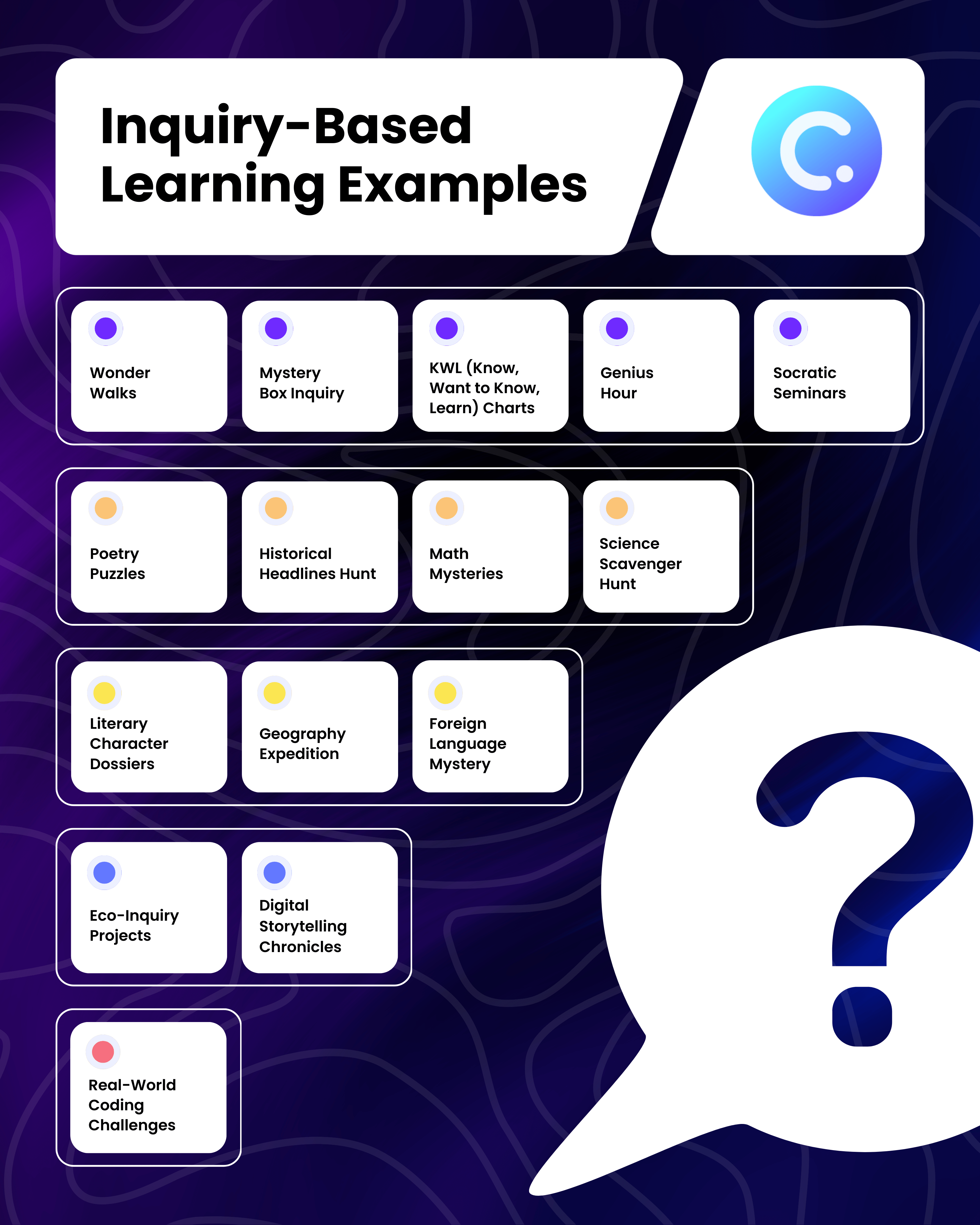
- Wonder Walks
- Mystery Box Inquiry
- KWL Charts
- Genius Hour
- Socratic Seminars
- Poetry Puzzles
- Historical Headlines Hunt
- Math Mysteries
- Science Scavenger Hunt
- Literary Character Dossiers
- Geography Expedition
- Foreign Language Mystery Dialogues
- Eco-Inquiry Projects
- Digital Storytelling Chronicles
- Real-World Coding Challenges
1. Wonder Walks
What it is: Wonder Walks transform ordinary outdoor strolls into dynamic learning experiences. Rather than being confined to the classroom, students venture outdoors to observe, question, and wonder about the natural world.
How to do it: Take your class to the school garden, a nearby park, or even the local neighborhood. Encourage students to observe and question their surroundings. For instance, they might wonder why certain plants thrive in specific areas or why the architecture in the neighborhood varies. This not only sparks curiosity but also sets the stage for future investigations in science, geography, or urban planning.
2. Mystery Box Inquiry
What it is: The Mystery Box Inquiry turns your classroom into a detective agency. An unknown object hides inside a box, and students become detectives, using their senses to gather clues, form hypotheses, and unveil the identity of the mysterious object.
How to do it: Select a range of objects related to your lesson and place them in a box. It could be artifacts for a history lesson, for example. Present the mystery box, and let students explore through touch, smell, and even gentle shakes. They then formulate hypotheses and questions about the object’s origin, purpose, or historical significance. This hands-on activity not only engages students but also hones their observational and deductive reasoning skills.
3. KWL Charts
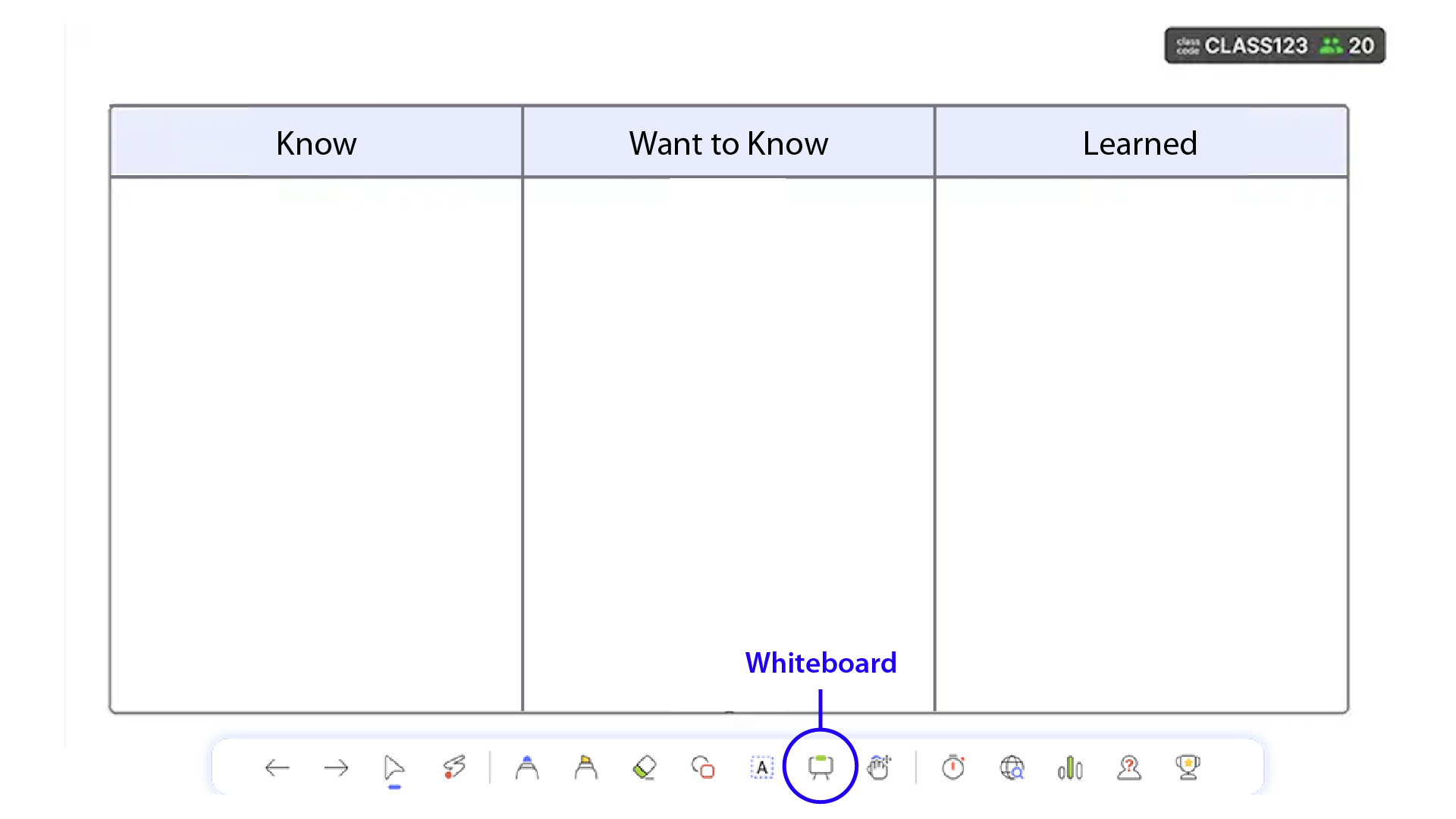
What it is: KWL charts (Know, Want to know, Learn) act as insightful roadmaps for lessons, tapping into prior knowledge and guiding students through what they want to discover and what they’ve learned.
How to do it: At the start of a new unit, ask students what they already know about the topic and what they’re curious to learn. Throughout the unit, encourage them to update the “Learned” column as they acquire new information. This method not only builds on existing knowledge but also instills a sense of ownership in the learning process.
Pull up a ClassPoint whiteboard to insert a pre-formatted / pre-saved KWL chart. Your students can then fill in the columns using Slide Drawing where they can directly interact with your slides, and submit it back as individual responses real-time!
4. Genius Hour

What it is: Genius Hour grants students dedicated time each week to explore their passions, promoting personalized learning and fostering a genuine love for acquiring knowledge.
How to do it: Set aside specific time each week for Genius Hour. Students can choose anything from researching climate change, learning a new instrument, to exploring potential career interests. The key is to let them take charge of their learning, fostering independence and a deep love for acquiring knowledge.
5. Socratic Seminars
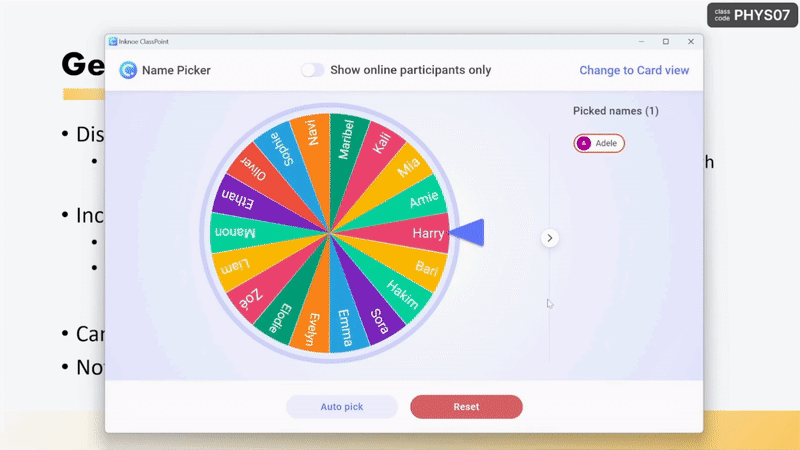
What it is: Socratic Seminars are dynamic discussions where students engage in open-ended dialogue, exploring complex questions related to a particular text or topic. It’s a student-led approach that encourages critical thinking and respectful exchange of ideas.
How to do it: Select a thought-provoking text or topic relevant to your curriculum. Prior to the seminar, guide students on how to formulate questions that promote critical thinking. During the seminar, students lead the discussion, challenging each other’s ideas and building on collective knowledge. This not only enhances understanding but also develops essential communication and analytical skills.
What better way to start a Socratic Seminar than kickstarting the open floor by drawing random names. Good thing, ClassPoint's Name Picker comes in handy with different modes of selection either via wheel of names, a deck of emoji cards, or auto-pick!
6. Poetry Puzzles
What it is: Poetry Puzzles infuse creativity into inquiry-based learning. Students explore poetic elements by solving puzzles created from famous poems, unraveling the mysteries of language and literary techniques.
How to do it: Select a captivating poem and deconstruct it into puzzle pieces. Distribute the pieces among students and challenge them to collaboratively reconstruct the poem. This not only enhances their understanding of poetic devices but also encourages teamwork and creative interpretation.
7. Historical Headlines Hunt

What it is: The Historical Headlines Hunt transforms history lessons into investigative adventures. Students delve into historical newspapers or articles, extracting information, and formulating questions about key events.
How to do it: Provide students with copies of historical newspapers or online articles related to a specific era. Ask them to explore and extract information to create a timeline of significant events. This activity sharpens research skills, historical analysis, and the ability to formulate meaningful inquiries.
Use ClassPoint's embedded browser to pull up online news articles to run the activity right inside PowerPoint.
8. Math Mysteries

What it is: Math Mysteries turn numerical concepts into intriguing puzzles. Students engage in real-world scenarios, applying mathematical principles to unravel mysteries and solve problems.
How to do it: Create scenarios or problem-solving situations related to your math lesson. For example, design a mystery where students need to use algebraic equations to uncover the unknown. This not only reinforces math skills but also demonstrates the practical application of mathematical concepts.
Use ClassPoint's Draggable Objects to invite students to drag and drop elements to solve math problems!
9. Science Scavenger Hunt
What it is: The Science Scavenger Hunt transforms the classroom into a scientific exploration zone. Students embark on a scavenger hunt to discover and collect items related to a specific scientific concept.
How to do it: Identify key concepts in your science curriculum and create a list of items or clues related to those concepts. Hide the items around the classroom or school, and let students hunt for them. This hands-on approach enhances their understanding of scientific principles while making learning a thrilling adventure.
10. Literary Character Dossiers

What it is: Literary Character Dossiers bring literature to life through investigative character analysis. Students delve deep into characters, exploring their motivations, relationships, and impact on the storyline.
How to do it: Assign each student a character from a novel or play. In their “dossier,” students compile information about the character’s traits, actions, and relationships. They can present their findings through written reports, visual presentations, or even dramatic performances. This activity fosters a deeper connection with literature and encourages critical analysis.
11. Geography Expedition
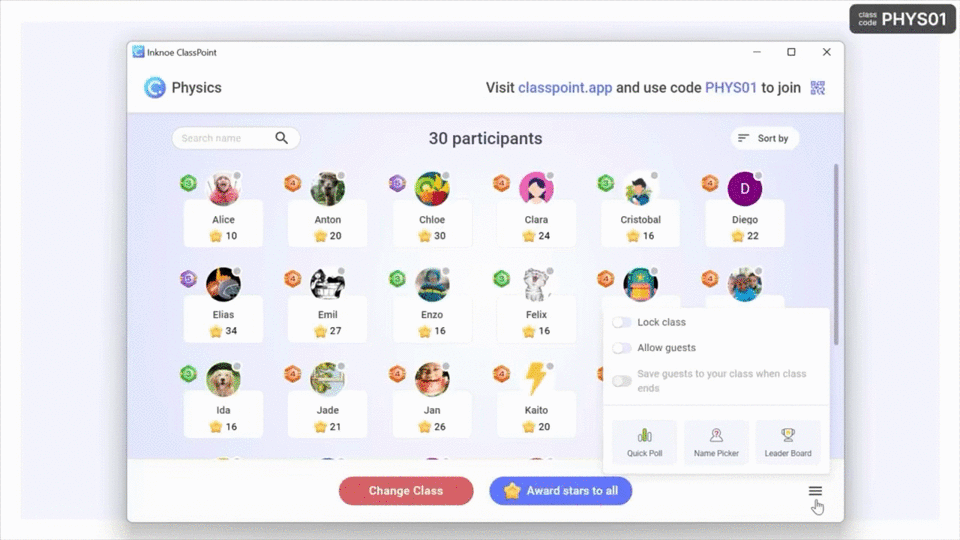
What it is: The Geography Expedition turns geography lessons into immersive journeys. Students explore maps, atlases, and digital resources to investigate geographical features, cultural landmarks, and global connections.
How to do it: Provide students with a list of geographical elements to explore, such as mountain ranges, rivers, or cultural landmarks. Equip them with maps or digital tools, and let them embark on a virtual or physical expedition. This activity enhances geographical literacy while fostering a sense of adventure and discovery.
Amp up the quest by giving your students rewards as they achieve different expedition milestones. Say hello to gamification in PowerPoint with ClassPoint's engineered point system that allows your students to collect stars, advance into levels with corresponding badges, and rank up the leaderboard!
12. Foreign Language Mystery Dialogues
What it is: Foreign Language Mystery Dialogues infuse language learning with intrigue. Students engage in mystery scenarios, communicating in the target language to solve problems and uncover information.
How to do it: Design mystery scenarios that require students to use the target language for communication. For example, create a scenario where they need to solve a mystery using clues provided in the foreign language. This activity not only enhances language skills but also makes learning a foreign language an exciting and purposeful experience.
13. Eco-Inquiry Projects

What it is: Eco-Inquiry Projects empower students to investigate and address environmental issues. They research, propose solutions, and take action to make a positive impact on their local or global environment.
How to do it: Identify environmental issues relevant to your community or globally. Assign students or groups specific issues to research, analyze, and propose solutions. This hands-on project instills a sense of environmental stewardship while honing research, presentation, and problem-solving skills.
Assigning students into groups? No sweat. Check out our blog on the best random name pickers here.
14. Digital Storytelling Chronicles
What it is: Digital Storytelling Chronicles merge technology and storytelling to engage students in creative inquiry. Students use digital tools to create multimedia narratives exploring historical events, literature, or personal experiences.
How to do it: Introduce digital storytelling platforms or tools. Assign students topics related to your curriculum, and have them create multimedia presentations incorporating images, audio, and text. This activity not only enhances technological literacy but also encourages creativity and effective communication.
15. Real-World Coding Challenges
What it is: Real-World Coding Challenges immerse students in authentic coding scenarios, connecting programming concepts with practical applications. Students tackle real-world problems using coding skills to develop solutions.
How to do it: Present students with coding challenges inspired by real-world issues or industries. For example, they might create a website to address a community need or develop a program to solve a simulated business problem. This activity not only enhances coding proficiency but also encourages problem-solving, creativity, and an understanding of the real-world applications of programming.
Pro Tips for Successfully Implementing Inquiry-Based Learning
Tip #1: Nurture a Classroom Culture of Inquiry
- Create a classroom where curiosity isn’t just allowed; it’s celebrated. Encourage students to ask questions, explore what interests them, and actively participate in shaping their learning journey. By making inquiry a cornerstone of your class, you set the stage for an engaging and dynamic learning environment.
Tip #2: Guide Students Through the Inquiry Process
- Give students a roadmap as they navigate the world of inquiry. Start with simpler activities, gradually ramping up the complexity. Provide frameworks for crafting questions, researching, and presenting findings. This way, students build a solid foundation in self-directed learning.
Tip #3: Champion Collaborative Exploration
- Highlight the strength of teamwork in inquiry-based projects. Urge students to collaborate, share insights, and learn from one another. Collaborative exploration not only makes learning more vibrant but also hones teamwork and communication skills crucial in real-world situations.
Tip #4: Connect Learning to the Real World
- Bridge the gap between classroom activities and the real world. Show how what they’re learning isn’t just confined to textbooks; it has real-world applications. This not only deepens understanding but also instills a sense of purpose, helping students see the broader impact of their learning beyond the classroom walls.
Tip #5: Offer Thoughtful Feedback and Reflection Opportunities
- Make reflection a regular part of the learning process. Create moments for students to assess their progress, identify areas for growth, and set goals. Alongside this, provide constructive feedback that guides them in honing their inquiry skills. Reflection isn’t just about looking back; it’s about fostering a mindset of continual improvement.
Food for Thought
Throughout our curation of everything IBL, one key ingredient stands out—curiosity. In the evolving classrooms of today, inquiry-based learning stands as an ode to that inherent drive to explore and understand. In our exploration of practical examples and insightful tips, what emerges is a simple truth: IBL brings heart to learning.
As educators, we become facilitators of an environment where questions are rather celebrated, instead of being discouraged. By guiding students through the learning process, and connecting lessons to real-world scenarios, we lay the groundwork for a love of learning that extends far beyond the classroom. Appreciating the beauty of inquiry, education transforms into a journey, each question a stepping stone towards a deeper understanding.